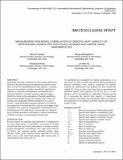| dc.contributor.author | O'Hanley, Harrison F. | |
| dc.contributor.author | Buongiorno, Jacopo | |
| dc.contributor.author | Hu, Lin-wen | |
| dc.contributor.author | McKrell, Thomas J. | |
| dc.contributor.author | Hu, Lin-Wen | |
| dc.date.accessioned | 2014-01-27T14:59:15Z | |
| dc.date.available | 2014-01-27T14:59:15Z | |
| dc.date.issued | 2011-11 | |
| dc.identifier.isbn | 978-0-7918-5496-9 | |
| dc.identifier.uri | http://hdl.handle.net/1721.1/84546 | |
| dc.description.abstract | Nanofluids are being considered for heat transfer applications. However, their thermo-physical properties are poorly known. Here we focus on nanofluid specific heat capacity. Currently, there exist two models to predict a nanofluid’s specific heat capacity as a function of nanoparticle concentration and material. Model I is a straight volume-weighted average; Model II is based on the assumption of thermal equilibrium between the particles and the surrounding fluid. These two models give significantly different predictions for a given system. Using differential scanning calorimetry, the specific heat capacities of water based silica, alumina, and copper oxide nanofluids were measured. Nanoparticle concentrations were varied between 5wt% and 50wt%. Test results were found to be in excellent agreement with Model II, while the predictions of Model I deviate very significantly from the data. | en_US |
| dc.language.iso | en_US | |
| dc.publisher | ASME International | en_US |
| dc.relation.isversionof | http://dx.doi.org/10.1115/IMECE2011-62054 | en_US |
| dc.rights | Creative Commons Attribution-Noncommercial-Share Alike 3.0 | en_US |
| dc.rights.uri | http://creativecommons.org/licenses/by-nc-sa/3.0/ | en_US |
| dc.source | Prof. Buongiorno via Chris Sherratt | en_US |
| dc.title | Measurement and Model Correlation of Specific Heat Capacity of Water-Based Nanofluids With Silica, Alumina and Copper Oxide Nanoparticles | en_US |
| dc.type | Article | en_US |
| dc.identifier.citation | O’Hanley, Harry, Jacopo Buongiorno, Thomas McKrell, and Lin-wen Hu. “Measurement and Model Correlation of Specific Heat Capacity of Water-Based Nanofluids With Silica, Alumina and Copper Oxide Nanoparticles.” ASME 2011 International Mechanical Engineering Congress and Exposition (IMECE 2011). In Volume 10: Heat and Mass Transport Processes, Parts A and B, 1209-1214. | en_US |
| dc.contributor.department | Massachusetts Institute of Technology. Department of Mechanical Engineering | en_US |
| dc.contributor.department | Massachusetts Institute of Technology. Department of Nuclear Science and Engineering | en_US |
| dc.contributor.department | MIT Nuclear Reactor Laboratory | en_US |
| dc.contributor.approver | Buongiorno | en_US |
| dc.contributor.mitauthor | O'Hanley, Harrison F. | en_US |
| dc.contributor.mitauthor | Buongiorno, Jacopo | en_US |
| dc.contributor.mitauthor | McKrell, Thomas J. | en_US |
| dc.contributor.mitauthor | Hu, Lin-Wen | en_US |
| dc.relation.journal | Proceedings of the ASME 2011 International Mechanical Engineering Congress and Exposition (IMECE 2011) | en_US |
| dc.eprint.version | Author's final manuscript | en_US |
| dc.type.uri | http://purl.org/eprint/type/ConferencePaper | en_US |
| eprint.status | http://purl.org/eprint/status/NonPeerReviewed | en_US |
| dspace.orderedauthors | O’Hanley, Harry; Buongiorno, Jacopo; McKrell, Thomas; Hu, Lin-wen | en_US |
| dspace.mitauthor.error | true | |
| mit.license | OPEN_ACCESS_POLICY | en_US |
| mit.metadata.status | Complete | |
